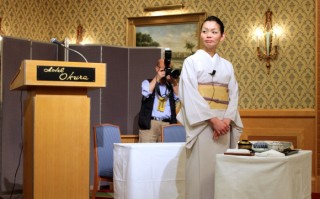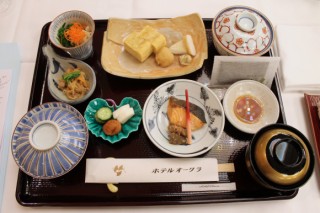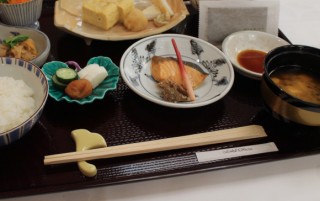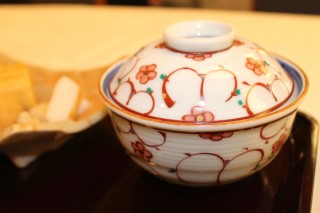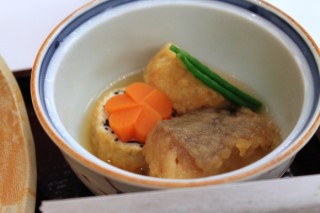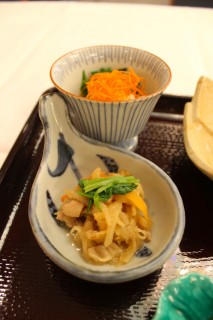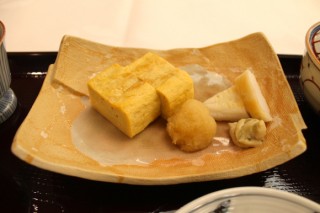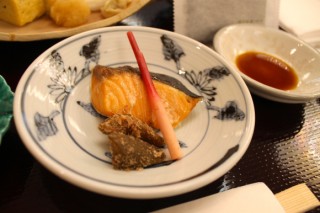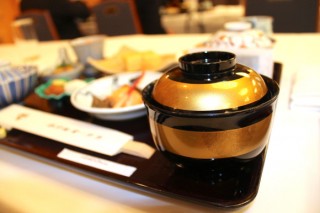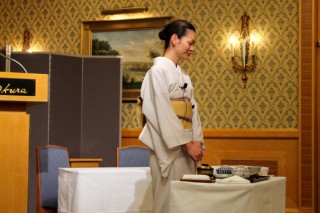Loading
Search
▼ Miss Manners: A Pro Gives us Pointers on Japanese Dining Decorum
- Category:Experience
Uh oh, have you been behaving like an oafish gaijin?
We were recently invited to an event promoting the health benefits of Japanese-style breakfasts or wachoshoku, held at Tokyo’s iconic Hotel Okura. As part of the schedule, we were treated to a dining etiquette lesson from Reiko Kobayashi, a staff member at their Japanese restaurant Yamazato.
▼ The lobby of Hotel Okura. On a side note, this is actually an annex building. The historic main structure was sadly demolished last year in order to rebuild ahead of the 2020 Olympics, breaking the hearts of Tokyo design fans.
First, let’s take a look at what wachoshoku is. The standard Japanese breakfast is ichiju sansai or one soup, three sides. This doesn’t count the rice or pickles, of course, which are considered so indispensable as to not be worth mentioning. The three side dishes are typically a piece of grilled fish, meat or tofu, a simmered vegetable dish and an egg dish.
▼ What we ate. If you are keeping track at home, this is more like ichiju, gosai (one soup, five sides), but it is a fancy restaurant after all.
▼ What we ate. If you are keeping track at home, this is more like ichiju, gosai (one soup, five sides), but it is a fancy restaurant after all.
So let’s start with the etiquette. According to Kobayashi-san, anytime you have a drink or food in front of you, you should put your napkin in your lap, with about a third folded over. This part is used for wiping your mouth and keeping it turned in means the dirty part will always be covered.
Now you may use your oshibori or damp towel. This is only for cleaning your hands and should not be used to clean your arms or face.
Next, prepare your chopsticks. With your right hand (assuming you are right-handed), pick up the chopsticks from the top. Pull off the paper sleeve and place it to the left of your tray. Move your left hand underneath to hold the chopsticks, then move your right hand under the chopsticks to hold them. If they are the type that needs to be pulled apart, you can split them now.
To put down the chopsticks, reverse the movements, putting your left hand underneath to switch the grip of your right hand from under to on top. Place the chopsticks back on the chopstick rest with about 3 cm resting over the edge.
▼ Your default chopstick position when you are not actively eating.
Before you dig in, remember to sit up straight and say itadakimasu!
Now you may use your oshibori or damp towel. This is only for cleaning your hands and should not be used to clean your arms or face.
Next, prepare your chopsticks. With your right hand (assuming you are right-handed), pick up the chopsticks from the top. Pull off the paper sleeve and place it to the left of your tray. Move your left hand underneath to hold the chopsticks, then move your right hand under the chopsticks to hold them. If they are the type that needs to be pulled apart, you can split them now.
To put down the chopsticks, reverse the movements, putting your left hand underneath to switch the grip of your right hand from under to on top. Place the chopsticks back on the chopstick rest with about 3 cm resting over the edge.
▼ Your default chopstick position when you are not actively eating.
Before you dig in, remember to sit up straight and say itadakimasu!
Now comes the fun part, actually eating! Kobayashi-san reminds us that the dishes are not meant to be eaten one at a time. Instead, enjoy the balance of the seasonal ingredients by flitting from dish to dish. Generally, you should eat a morsel of food with a bite of rice.
▼ Even the dishes get in on the seasonal theme. Here we have a pattern of plum blossoms to mark the February emergence of the fragrant blossoms.
▼ Even the dishes get in on the seasonal theme. Here we have a pattern of plum blossoms to mark the February emergence of the fragrant blossoms.
The soup is usually eaten at the end of the meal, but you can remove the lids from the rice and simmered dish. To do so, hold the dish with your left hand and pick up the lid with your right. Place the lids upside-down on the table or tray on whichever side is closest. Placing it upside-down protects the table or the lacquer tray from water droplets and staining.
▼ A dish of fry-simmered sable fish, hijiki-shinoda roll, greens and a carrot carved to look like plum blossoms. Those little touches really wow.
▼ A dish of fry-simmered sable fish, hijiki-shinoda roll, greens and a carrot carved to look like plum blossoms. Those little touches really wow.
Hunching over the table to eat is considered bad manners. Instead, most of the dainty dishes can be lifted into your hands and held in the left and brought close to your mouth while you handle the chopsticks with your right.
▼ These two side dishes are clearly small enough to be lifted off the table. The kobachi or small stewed dish even has a handy little… ah, handle.
▼ These two side dishes are clearly small enough to be lifted off the table. The kobachi or small stewed dish even has a handy little… ah, handle.
The larger dishes are not meant to be lifted, however. As a rule of thumb, Kobayashi-san says that if a dish would fit comfortably in your palm, it can be picked up. If not, leave it on the table. If you are worried about dropping bits of food, you can use the lid from the simmered dish as a kind of plate. In that case, pick it up with your left hand, squeezing the small ring between your pointer and middle finger for leverage. Place each bite on the lid to ferry it to your mouth or hold the lid under the chopsticks to catch anything that falls.
▼ The heavier ceramic dish for the eggs would be too unwieldy to lift. Also, the grated daikon radish is meant to be used as a palate cleanser after the sweet egg omelette, not to be eaten with it. Whoops! Your author has been messing that one up.
▼ The heavier ceramic dish for the eggs would be too unwieldy to lift. Also, the grated daikon radish is meant to be used as a palate cleanser after the sweet egg omelette, not to be eaten with it. Whoops! Your author has been messing that one up.
With grilled fish or fish with the head attached, each bite should be separated from the left-hand side, one at a time, without distorting the overall shape of the fish. The raw ginger stem (hajikami) serves to eliminate fish breath, so save it until the end to cleanse your palate.
▼ That pink stick is the hajikami.
▼ That pink stick is the hajikami.
If at any point you would like more rice, leave a few grains in your bowl. This shows appreciation to the staff for noticing before you finished eating everything. Of course, it’s fine to ask for a refill too. If you finish all of the rice, this signals you are full and don’t need any more.
The soup is usually eaten last. As before, remove the lid and place it upside-down on the table or tray to your right.
▼The lacquer soup bowl also has a beautiful seasonal fern design.
When you are finished with your meal, place all of the lids back on their dishes as before. Do not put them upside down on top of the bowl, as moisture and food scraps can damage the surface.
The soup is usually eaten last. As before, remove the lid and place it upside-down on the table or tray to your right.
▼The lacquer soup bowl also has a beautiful seasonal fern design.
When you are finished with your meal, place all of the lids back on their dishes as before. Do not put them upside down on top of the bowl, as moisture and food scraps can damage the surface.
And that’s it! Gochisosama, Kobayashi-san.
This article deals specifically with the etiquette of a Japanese breakfast, in which the dishes are served all at once, but many of the tips apply to Japanese-style dining at lunch and dinner as well. It may seem complicated, but each principle has a functional rationale and makes elegant sense when understood.
The best advice I can give you, though, is to just enjoy the artistic presentation and delicious seasonal flavors without worrying too much about your Ps and Qs. Your chef will be more pleased to hear you enjoyed the meal than to see you eat it with perfect correctness.
Of course, some people are stricter than others…
The best advice I can give you, though, is to just enjoy the artistic presentation and delicious seasonal flavors without worrying too much about your Ps and Qs. Your chef will be more pleased to hear you enjoyed the meal than to see you eat it with perfect correctness.
Of course, some people are stricter than others…
- February 24, 2017
- Comment (0)
- Trackback(0)


